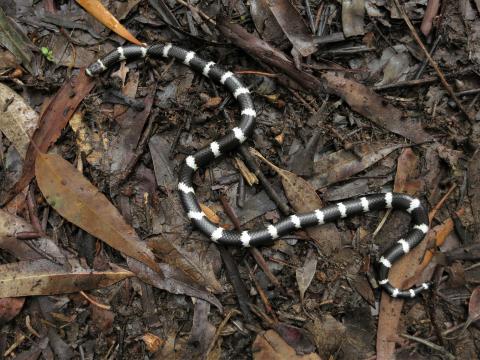Landholder Ken Rubeli describes his conservation agreement property, located next to Barrington Tops National Park, as a naturalist’s paradise, and it’s hard to disagree.
He has called the Dungog region home for more than 40 years and spent much of that time running Wangat Lodge, an Environmental Education Centre where he has hosted more than 500 school camps, offering students a chance to experience and connect with the Australian bush.
His new focus has shifted to the ongoing restoration and protection of Mundhuk Heritage Reserve - a 15 hectare conservation agreement landholding that’s proven a thriving haven for native flora and fauna, including a rich variety of snakes.
While his interest in snakes may not align with everyone’s vision of paradise, Ken is a strong advocate for their crucial role in keeping ecosystems balanced and healthy.
“There’s this tendency to amplify the danger of snakes,” Ken says.

“But they’re graceful, beautiful creatures. They visit my home now and then, and I’m used to gently coaxing them into a container and releasing them a bit further off.
"I worked for more than a decade in the rainforests of Malaysia and to most Malaysians I think there is a measure of fear of the forest - think tigers, elephants, snakes, leeches. The diversity of snakes there had me fascinated, but of course there's so many species here too.”
Recently, Ken shared a sighting of the elusive nocturnal bandy-bandy snake (Vermicella annulata) with the Land Libraries community on NatureMapr. With their distinctive black and white rings, these burrowing snakes are particularly vulnerable to predation by foxes and cats due to their lack of camouflage.
His encounters over the years read like a herpetologist’s dream: diamond pythons in the rafters, golden-crowned snakes under the bath, green tree snakes in the laundry, and the occasional red-bellied black snake slithering along the verandah.
“You get to know them,” he says. “They’re just part of the landscape.”
In his time at Mundhuk, Ken has seen the forest steadily reclaim its strength. Invasive lantana has been almost entirely eradicated. Towering tallowwoods and blue gums shade a thriving rainforest understory, and the reserve has remained untouched by bushfires for more than 60 years.
As well as being a vital in-perpetuity conservation refuge, it’s a living field lab. Through initiatives like Land Libraries, Ken now uses motion-sensor cameras and online tools to document his wildlife sightings. A recent image sparked debate in the Land Libraries community over whether it showed a rare parma wallaby or a young red-necked wallaby.
“I await further images to be certain,” he laughs. “But that’s the joy of it, you’re always learning.”
His cameras have also recorded long-nosed potoroos carrying young, a sign these vulnerable marsupials are thriving, thanks to the apparent absence of feral cats on the property.
Ken says his relationship with the land goes far beyond just observing and recording. He envisions a future where privately protected habitats form a mosaic across the Australian landscape, linked by corridors of native trees and carbon-rich woodlands.
“The diversity here is amazing, but I’ve never felt the proprietor of the land. I’m a custodian. It’s not mine,” he says.
“I just hope my children, grandchildren, or whoever comes next carries on that role.
“I have always wanted to introduce young people to the Australian bush. The idea was always about sowing seeds, not just trees, but ideas, an appreciation for nature, and a sense of custodianship.
“We could transform the land if more people felt this kind of care. If only a love for wildlife and wild places was more contagious.”
A refuge for rare and vulnerable species Munduk Heritage Reserve provides critical habitat for several threatened species. Local sightings include:
- Spotted-tailed Quoll (Dasyurus maculatus), vulnerable
- Stephens’ banded snake (Hoplocephalus stephensii), vulnerable
- Stuttering frog (Mixophyes balbus), endangered
- Glossy black-cockatoo (Calyptorhynchus lathami), vulnerable
- Wompoo Fruit-Dove (Ptilinopus magnificus), vulnerable
- Masked Owl (Tyto novaehollandiae), vulnerable
- Koala (Phascolarctos cinereus), endangered
- Yellow-bellied glider (Petaurus australis), vulnerable